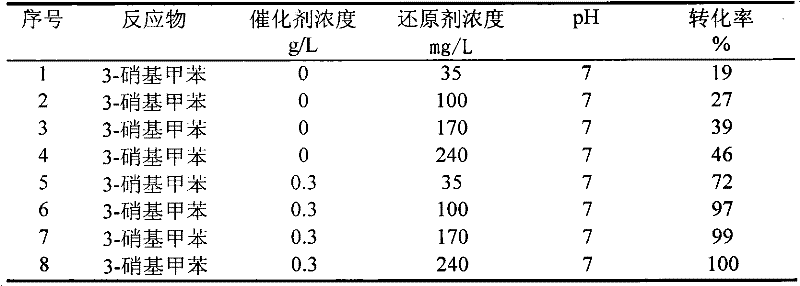Method for reduction treatment of nitrotoluene wastewater by using jujube-wood-sourced charcoal for catalyzing
A technology of nitrotoluene and jujube wood, which is applied in the field of catalytic reduction treatment of nitrotoluene wastewater from jujube wood source charcoal, achieving significant environmental and economic advantages, simple preparation, and simple and easy methods
- Summary
- Abstract
- Description
- Claims
- Application Information
AI Technical Summary
Problems solved by technology
Method used
Image
Examples
Embodiment 1
[0024] Embodiment 1: Hydrosulfide reduction of 3-nitrotoluene
[0025] In 8 200ml anaerobic simulated reactors, adding pH is 7 phosphate buffers and concentration is the 3-nitrotoluene waste water of 100mg / L, is filled with 99.99% high-purity nitrogen in reactor (to remove reaction Oxygen in the system forms an anaerobic environment), add 35mg / L, 100mg / L, 170mg / L, 240mg / L reducing agent hydrosulfide respectively in the reactor, then, do not add catalyst in No. 1-4 reactor , in No. 5-8 reactor, add 60mg jujube source charcoal respectively (make its concentration be 0.3g / L) as reaction catalyst. The reactor was sealed and placed in a rotary oscillator, and the reaction was shaken at a speed of 150-200 rpm for 72 hours at normal temperature and pressure. The conversion rate of nitrotoluene is shown in Table 1.
[0026] The conversion rate of nitrobenzene under table 1 hydrogen sulfide reduction condition
[0027]
Embodiment 2
[0028] Example 2: Hydrosulfide reduction of 2-nitrotoluene, 3-nitrotoluene and 4-nitrotoluene
[0029] Different from Example 1, 100 mg / L of reducing agent hydrosulfide was added to 6 reactors respectively, then, no catalyst was added in No. 1-3 reactors, and 60 mg was added respectively in No. 4-6 reactors Jujube source charcoal (to make its concentration 0.3g / L) was used as a reaction catalyst. The reactor was sealed and placed in a rotary shaker, and the reaction was shaken at a speed of 150-200 rpm for 72 hours at normal temperature and pressure. The conversion rate of nitrotoluene is shown in Table 2.
[0030] The conversion rate of nitrotoluene under table 2 hydrosulfide reduction conditions
[0031]
Embodiment 3
[0032] Embodiment 3: Reductive conversion of 3-nitrotoluene under different catalyst concentration conditions
[0033] Different from Example 1, in 5 reactors, add respectively the reductant hydrosulfide of 100mg / L, then, add a certain amount of jujube wood source charcoal respectively in the reactor (making its concentration be 0.1,0.3,0.5 , 0.7, 1.0g / L) as the reaction catalyst. The reactor was sealed and placed in a rotary shaker, and the reaction was shaken at a speed of 150-200 rpm at normal temperature and pressure for 72 hours. The conversion rate of 3-nitrotoluene is shown in Table 3.
[0034] Table 3 Reduction transformation of 3-nitrotoluene under different catalyst concentration conditions
[0035]
PUM
| Property | Measurement | Unit |
|---|---|---|
| concentration | aaaaa | aaaaa |
| specific surface area | aaaaa | aaaaa |
Abstract
Description
Claims
Application Information
 Login to View More
Login to View More - R&D Engineer
- R&D Manager
- IP Professional
- Industry Leading Data Capabilities
- Powerful AI technology
- Patent DNA Extraction
Browse by: Latest US Patents, China's latest patents, Technical Efficacy Thesaurus, Application Domain, Technology Topic, Popular Technical Reports.
© 2024 PatSnap. All rights reserved.Legal|Privacy policy|Modern Slavery Act Transparency Statement|Sitemap|About US| Contact US: help@patsnap.com










